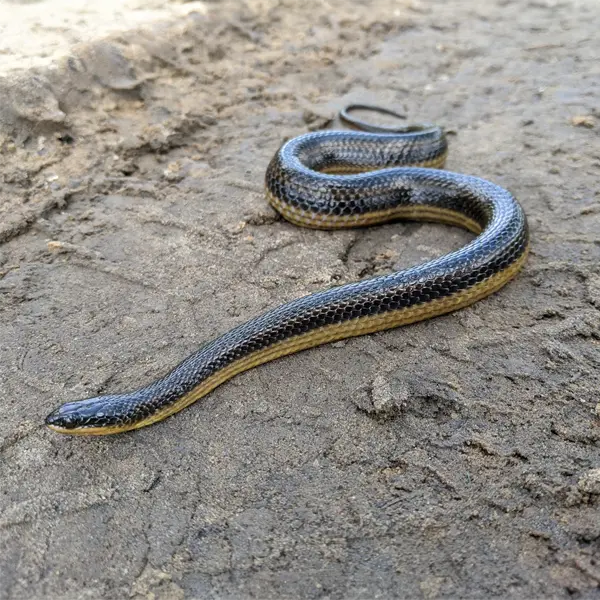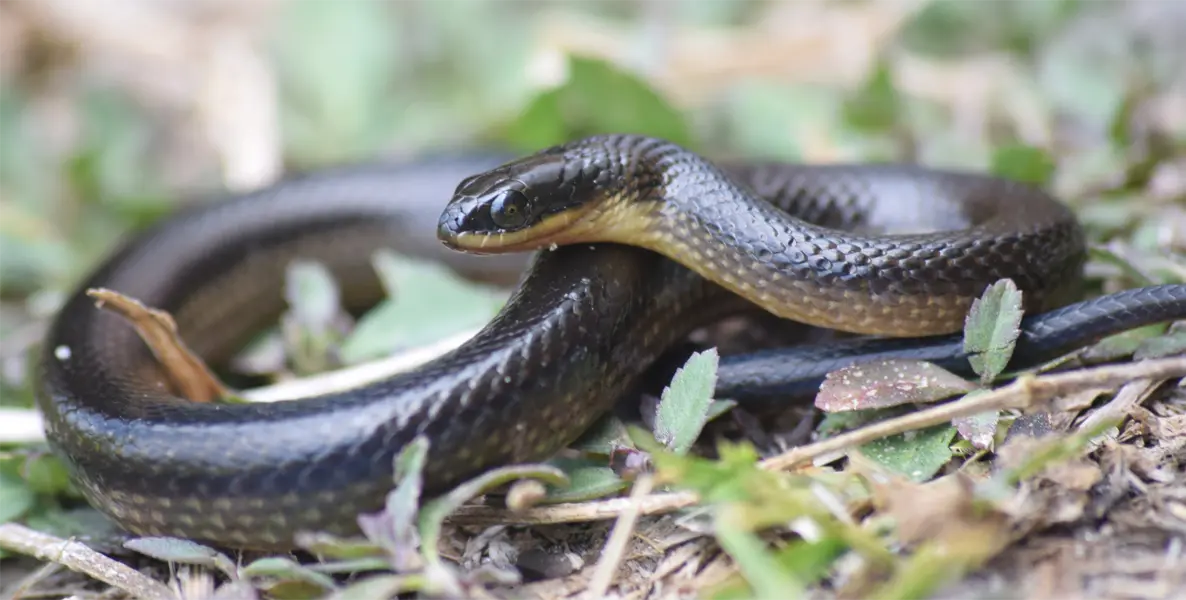Striped Swampsnake
- Scientific Name
- Liodytes alleni
- Also Known As
- Striped Crayfish Snake
- Range
- All of Florida, Except the Western Panhandle
- Diet
- Small Amphibians, Fish
- Life Expectancy
- 4 - 6 Years
Quick Links
The Striped Swampsnake in Central Florida
The striped swampsnake (Liodytes alleni) is a small, nonvenomous colubrid species found in wetland habitats across the southeastern United States. In central Florida, striped swampsnakes inhabit freshwater marshes, swamps, streams, and drainage ditches, where they feed on amphibians and small fish.
This guide provides identification tips, biology facts, and information on striped swampsnake habits and habitat preferences in central Florida.
Appearance and Identification
Striped swampsnakes can be identified by the following physical characteristics
Photo 14566614 © Nicholus ledbetter, CC BY-NC
Adult Striped Swampsnakes
Juvenile Striped Swampsnakes
The small size, divided anal plate, and short tail help distinguish striped swampsnakes from lookalike water snakes and ribbon snakes. They lack the broad, dark collar characteristic of rough green snakes.
Maturation Rate
Young striped swampsnakes grow rapidly, more than doubling in size within the first year. They shed frequently as juveniles, allowing quick increases in length. Sexual maturity is reached by age 2 at the latest.
Habits and Behavior
Striped swampsnakes are mostly active at night or early morning, spending the day hidden under logs, leaf litter, rocks, or other natural debris near the water’s edge. They are secretive, slow-moving snakes that rely on cryptic coloration to avoid detection. If threatened, they may flatten their bodies to appear larger or release a foul-smelling musk.
Striped swampsnakes are excellent swimmers and divers, propelling themselves with side-to-side motions. On land, they move in a straight line rather than sidewinding. Home ranges are small, usually less than a hectare near suitable wetlands. Striped swampsnakes hibernate communally in underground burrows or hollow logs from November through March in central Florida.
Reproduction and Lifespan
Mating takes place from March to May, soon after emergence from brumation. Females lay 3-15 eggs in decomposing vegetation or under rocks from late April through July. The eggs are oblong, small (1 inch/2.5 cm), and white, taking 50-65 days to hatch. Hatchlings are independent immediately.
Striped swampsnakes likely reach maturity in their second year. Typical lifespan is estimated between 4-6 years, though individuals over 10 years old have been recorded in the wild.
Ideal Habitat and Range
Central Florida’s low-lying wetlands and abundant waterways provide ideal habitat for striped swampsnakes. The subtropical climate brings hot, humid summers and mild, drier winters. Average highs range from the mid-70s°F in January to the low 90s°F from June to September. Rainfall averages over 50 inches annually.
Standing and slow-moving fresh waters like marshes, cypress swamps, ponds, lakes, streams, and canals are preferred, along with wet woods and grassy areas nearby. Striped swampsnakes require moist microhabitats with muddy or loose soils for foraging, shelter, and egg-laying. Drainage ditches, flooded fields, swales, and retention ponds also provide suitable habitat.
Diet and Feeding
Striped swampsnakes are carnivorous, feeding almost exclusively on small amphibians like frogs, toad and salamander larvae, and sirens. They also take small fish like killifish and mollies. Juveniles eat worms, insect larvae, and other soft-bodied invertebrates.
Foraging takes place along water margins and wetland vegetation, searching for prey under debris or by probing muddy substrates. Striped swampsnakes swallow food whole, facilitated by their expandable jaws. Food passes through the digestive tract within 2-3 days before excretion.

Photo 255704232 © stevewalternature, CC BY-ND

Common Health Risks
Striped swampsnakes pose minimal risks to human health and safety. They have tiny, rear-facing teeth used to grip slimy prey and lack venom. Opossums, raccoons, birds of prey, and large fish prey upon striped swampsnakes. Their defensive tactics include musking, flattening, and thrashing.
While not harmful, striped swampsnakes may trigger phobias in individuals with severe ophidiophobia or herpetophobia. Their unexpected presence could startle and cause someone to trip or fall. Proper wetland precautions regarding snakes, alligators, and insects should be taken in central Florida.
Preventing Striped Swampsnakes
Striped swampsnakes naturally inhabit aquatic ecosystems and provide pest control services by eating amphibians, fish, and invertebrates. Prevention involves coexistence and exclusion from areas like homes and yards:
- Install screens on windows and doors and seal gaps to exclude snakes.
- Trim vegetation and remove debris piles around the home to reduce snake shelter.
- Prevent access to pools by erecting fences and using pool covers.
- Inspect items stored in sheds and garages before handling.
- Exercise caution and wear snake leggings and boots when hiking near wetlands.
Striped Swampsnakes in Central Florida – Conclusion
In summary, striped swampsnakes are small, nonvenomous water snakes well adapted to Florida’s many freshwater wetlands, streams, ponds, and drainage canals. They serve as important amphibian and insect predators within these habitats.
Striped swampsnakes present minimal risks to humans and can be prevented from entering homes and yards through proper exclusion and habitat modification tactics. Their presence indicates healthy local aquatic ecosystems.






